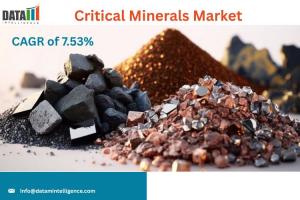Critical Minerals Market Growth 2025 | Global Demand, Trends & Opportunities | DataM Intelligence
The Global Critical Minerals Market is expected to reach at a CAGR of 7.53% during the forecast period 2025-2032.
Market Overview:
Critical minerals like lithium, cobalt, rare earth elements (REEs), nickel, graphite, manganese, tungsten, and copper are essential for producing electric vehicles (EVs), renewable energy technologies, consumer electronics, aerospace and defense systems, and industrial machinery. The growing demand for these minerals is primarily driven by the worldwide transition toward sustainable energy solutions.
The International Energy Agency (IEA) reports that mineral demand for clean energy technologies is projected to nearly quadruple by 2040, with lithium demand expected to increase nine fold. Copper, a vital component in electrification, is anticipated to see the largest absolute growth, with clean energy applications accounting for over 40% of total demand for copper and REEs, 60–70% for nickel and cobalt, and nearly 90% for lithium.
Download Sample Report Here: https://www.datamintelligence.com/download-sample/critical-minerals-market
Market Drivers and Opportunities:
The following are the main factors driving the critical minerals market's expansion:
Energy Transition Technologies: The shift towards EVs, solar panels, wind turbines, and energy storage systems is driving the demand for critical minerals.
Geopolitical Dynamics: Efforts to diversify supply chains and reduce dependence on dominant producers are fostering international collaborations and investments.
Technological Advancements: Innovations in recycling, alternative materials, and mining technologies are enhancing supply chain resilience and sustainability.
Opportunities abound in regions rich in mineral resources, including parts of Africa, Latin America, and Asia-Pacific, as countries seek to develop and secure their critical mineral supplies.
Market Segmentation:
By Mineral Type:
Lithium
Cobalt
Rare Earth Elements (REEs)
Nickel
Graphite
Manganese
Tungsten
Copper
Others.
By Extraction Method:
Primary Mining
Secondary Recycling (Urban / End-of-life Products)
Brine Extraction
Ore Processing
Others.
By Application:
Electric Vehicles (EVs)
Renewable Energy
Consumer Electronics
Aerospace & Defense
Industrial Machinery
Energy Storage Systems
Others.
By Region:
North America
South America
Europe
Asia Pacific
Middle East
Africa.
Geographical Market Share:
The critical minerals market is geographically diverse, with significant contributions from:
North America: The U.S. is focusing on domestic production, with companies like MP Materials leading efforts to establish a fully integrated rare earth magnet manufacturing facility in Texas.
Asia-Pacific: Japan is investing in diversified supply chains and recycling technologies to reduce reliance on imports, while South Korea is expanding its eco-friendly vehicle market and exploring new export markets.
Africa and Latin America: Countries like the Democratic Republic of Congo are engaging in international partnerships to develop their mineral resources, aiming to reduce dependence on dominant suppliers.
Key Players:
Prominent companies in the critical minerals market include:
Albemarle Corporation
Livent Corporation
Lynas Rare Earths Limited
MP Materials Corp.
Glencore plc
Iluka Resources Limited
Rio Tinto Group
Pilbara Minerals Limited
Canada Nickel Company Inc.
Recent Developments:
United States (2024–2025):
Expansion of Rare Earth Magnet Production: In January 2025, MP Materials began producing neodymium and praseodymium (NdPr) metal at its Fort Worth, Texas facility, marking the first time rare earth magnets are processed in the United States.
International Partnerships: In May 2025, MP Materials entered an agreement with Saudi Arabian Mining Company (Ma'aden) to establish a rare earth supply chain in Saudi Arabia, reflecting the United States' strategic goals to diversify its mineral supplies.
Japan (2024–2025):
Diversification of Dysprosium Supply Chains: Japan is collaborating with rare earth miners in Australia, the United States, and Vietnam to mitigate supply disruptions and geopolitical risks associated with dysprosium, a critical component for electric vehicles and renewable energy technologies .
Advancements in Recycling Technologies: Japan is investing in the development of advanced recycling facilities to efficiently recover rare earth metals from electronic waste, aiming to reduce import dependency and enhance sustainability .
Stay informed with the latest industry insights-start your subscription now: https://www.datamintelligence.com/reports-subscription
Conclusion:
The critical minerals market is at a pivotal juncture, with nations worldwide recognizing the strategic importance of securing reliable and sustainable supplies. Through international collaborations, technological innovations, and policy initiatives, countries are positioning themselves to meet the growing demand for these essential resources, ensuring a resilient foundation for the global energy transition.
Related Reports:
Precious Metal Market
Green Steel Market
Sai Kiran
DataM Intelligence 4Market Research
+1 877-441-4866
Sai.k@datamintelligence.com
Visit us on social media:
LinkedIn
X
Legal Disclaimer:
EIN Presswire provides this news content "as is" without warranty of any kind. We do not accept any responsibility or liability for the accuracy, content, images, videos, licenses, completeness, legality, or reliability of the information contained in this article. If you have any complaints or copyright issues related to this article, kindly contact the author above.
Patrick and Josh Lange of Business Modification Group Sell Established HVAC Company in Broward County
Southeast Addiction Center Atlanta Highlights the Urgent Need for Comprehensive Alcohol Addiction Treatment
The World’s First Literacy-Themed Gas Stations Launch a Summer Reading Adventure for Kids
Kalendarium
Więcej ważnych informacji
 Jedynka Newserii
Jedynka Newserii

 Jedynka Newserii
Jedynka Newserii

Transport

Import materiałów budowlanych z Rosji zagrożeniem dla konkurencyjności europejskiego rynku. Konieczne są zmiany i egzekwowanie sankcji
Unia Europejska powinna zrewidować politykę celną na import materiałów budowlanych spoza państw członkowskich, w tym państw wschodnich – twierdzą uczestnicy konferencji „Bezpieczeństwo gospodarcze UE”. Obecnie Wspólnota nakłada na europejskich producentów coraz więcej ograniczeń, nie rewidując polityki celnej, co przekłada się na systematyczne osłabienie konkurencyjności przedsiębiorstw, spadek produkcji i zagrożenie dla miejsc pracy.
Konsument
Polacy odczuwają brak wiedzy na temat inwestowania. Może to sprzyjać podejmowaniu nieracjonalnych decyzji finansowych

Co trzeci Polak odczuwa brak wiedzy w obszarze inwestowania, a tylko co piąty chciałby pogłębić swoją wiedzę na ten temat – wynika z badania „Poziom wiedzy finansowej Polaków 2025”. Ci, którzy na własną rękę szukają informacji i porad, coraz częściej sięgają do blogów, portali, podcastów i wideo w internecie. Eksperci przestrzegają, że finansowych i inwestycyjnych porad udzielają nie tylko specjaliści w danej dziedzinie, więc potrzebna jest zasada ograniczonego zaufania.
Handel
Do 2030 roku liczba plastikowych opakowań w e-handlu modowym może się podwoić. Ich udział najszybciej rośnie w Polsce

Wraz ze wzrostem kanału e-commerce w branży modowej rośnie liczba wykorzystywanych opakowań, z których znaczną część wciąż stanowią te z plastiku. Do 2030 roku w Polsce e-sprzedawcy zużyją 147 mln plastikowych opakowań – wynika z badania przeprowadzonego na zlecenie DS Smith. Można zauważyć rosnący trend wśród marek modowych, które coraz częściej wybierają opakowania wykonane z papieru lub materiałów z recyklingu. To o tyle istotne, że polscy konsumenci odczuwają wyrzuty sumienia z powodu ilości plastiku, w którym dostarczane są ich zamówienia.
Partner serwisu
Szkolenia

Akademia Newserii
Akademia Newserii to projekt, w ramach którego najlepsi polscy dziennikarze biznesowi, giełdowi oraz lifestylowi, a także szkoleniowcy z wieloletnim doświadczeniem dzielą się swoją wiedzą nt. pracy z mediami.









.gif)

 |
| |
| |
|